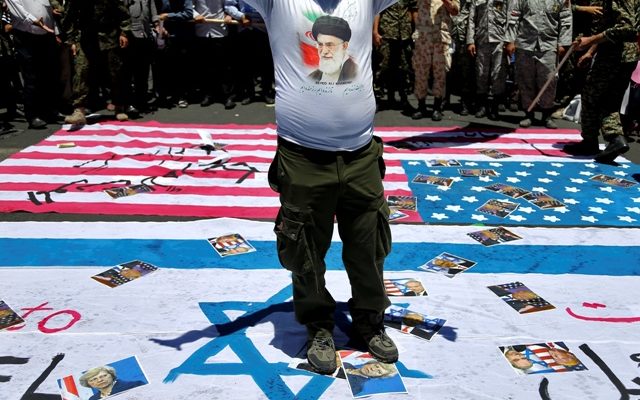Once a friend to Israel, Tehran overnight became an archenemy dedicated to its destruction. What was the source of such virulent and apparently indestructible hostility?
By Dr. Doron Itzchakov, BESA Center
Iran’s overnight shift from Israel’s friend to its archenemy was a strange and shocking turn of events. The two countries do not share a common border, and there is no conflict between them regarding the presence of an ethnic or religious minority – including the Jewish community living in Iran. So what was the source of such virulent and apparently indestructible hostility?
To answer this question, it is helpful to examine the pattern of bilateral relations that developed between the countries not long after the establishment of the State of Israel.
Bilateral relations between monarchist Iran and Israel began to warm gradually upon Iran’s de facto recognition of Israel in March 1950. Iran was the second Muslim country after Turkey to recognize Israel and even opened consular representation in Jerusalem. The relationship was established during a period of global and regional change that influenced Tehran’s geopolitical status, both as a buffer between East and West and within the Muslim world.
Iran had to position itself in the new international order. It was a Shiite monarchy in the heart of a volatile Sunni region that was being shaken by new waves of Arab nationalism. At the same time, the regime had to respond to the challenges posed by the Cold War’s bipolarity, as well as meet domestic challenges while stabilizing Iran’s sociopolitical fabric.
Iran-Israel relations were formed as a result of a convergence of interests that took shape around four main interfaces:
– The oil trade
– Intelligence and security relations, which became the main axis of relations at the beginning of 1958 and grew in intensity after the July 1958 coup d’état in Iraq
– Trade relations, which expanded enormously in the mid-1960s
– The assistance Israel agreed to provide Iran in a wide range of areas, such as agriculture, rehabilitation after natural disasters, improvement of water resources, rural rehabilitation, and more.
These ties were considered anathema by many and were the subject of criticism both within Iran and abroad.
The revolutionary narrative presents Ayatollah Khomeini as the main opponent of the bilateral relationship and, indeed, of Israel’s very existence. In fact, not only was Khomeini not among the first opponents of the Iranian-Israeli connection, but his rise to prominence in this respect occurred with the publication of the Basic Principles of the Shah’s “White Revolution” in the early 1960s, though his age and standing enabled him to voice his opposition much earlier.
In contrast, there were others, such as Ayatollah Abul Qassem Kashani and Navvab Safavi, who had preached against the nascent Iranian-Israeli ties since their establishment.
The year 1961 brings radical change
The reasons why Khomeini refrained from going public with his opposition until the 1960s are beyond the scope of this essay, but suffice it to say that he did not dare challenge the line of Grand Ayatollah Hossein Borujerdi – the marja taqlīd at the time – who advocated maintaining a separation between religion and politics. However, after Borujerdi’s death in March 1961, things changed radically.
The Shah’s apprehensions about Qom’s growing preeminence and his desire to establish Najaf (under the leadership of Ayatollah Muhsin al-Hakim) as the spiritual center of Shiite Islam roused Khomeini’s anger and caused him to take a public stance against the monarch. Khomeini’s ascendancy as an opponent of the regime was also aided by an intersection of interests between himself and the Egyptian ruler, Gamal Abdel Nasser – the Shah’s main nemesis.
Muslim scholars, Shiite and Sunni alike, have long debated the question: Under what conditions can a Muslim ruler be overthrown?
The basic premise was that a Muslim ruler is preferable to anarchy, even if he does not strictly obey Islamic commandments. This perception was considered acceptable among senior officials in the Shiite establishment, such as the Ayatollahs Khonsari and Shariatmadari. Khomeini, too, addressed this difficult question, publicizing the major change in his policy via the Basic Principles of the “White Revolution.”
The “White Revolution” caused waves of resistance and protest throughout Iranian society, during which time Khomeini disseminated his worldview regarding the illegitimacy of the Shah’s rule on the grounds of his ties with the U.S. and Israel. In his many speeches, he combined opposition to reforms with revulsion at the Shah’s rule and his relations with Israel. Khomeini’s argument was that the connection contradicted the principles of Islam as well as Iranian social mores, and did not reflect the will of the people.
On June 3, 1963, Khomeini delivered a speech full of hatred against the Shah and Israel, and was subsequently arrested and imprisoned. In April 1964, the authorities granted his release and he returned to the city of Qom. However, in late October 1964, he was rearrested following a speech condemning the immunity law granted by Iran to US representatives.
In November 1964 Khomeini was exiled from Iran. After a short period in Turkey he settled in Najaf, Iraq, where he worked on forming a resistance movement under his leadership.
‘Iranian Liberation Movement’
The timing of Khomeini’s arrival in Iraq worked out well for him. It was during the reign of Abdel Salam Aref, who maintained close ties with Nasser and allowed him to increase his influence in Iraq. This made it easier for Khomeini to establish the resistance movement, which he called the “Iranian Liberation Movement.”
The movement contained various streams that united for a common purpose. It included elements from the national front, factions from the Iranian left, and branches of the religious establishment, which was not monolithic. Some followed the line of Khomeini, whose aim was to oust the Shah and establish an Islamic government. Others aspired to reduce the Shah’s power and restore the constitutional monarchy.
Khomeini’s teachings were based on the notion that Islam in general and Iran in particular were under attack by the West in a number of realms (military, economic, and cultural), and a counterattack was needed. In his proclamations, one can identify the influences of other thinkers, such as Sayyid Qutb, Ali Shariati, and Jalal al-Ahmad. A basic component of their thinking was hostility towards Israel. Khomeini emphasized that element to discredit the Shah and cast his leadership as illegitimate.
Khomeini elected to link up with militant movements that believed the political effort would not achieve its goal without violent resistance. The first was Hayat-ye moatalefe-ye Eslāmi, which was established after Khomeini’s release from prison and which was involved in the assassination of PM Hassan Ali Mansour in 1965.
At the same time, a movement of Iranian dissidents, mostly students, began to organize outside Iran’s borders. They established a militant underground group, Sama, which received training in Egypt. That training continued until the end of 1966, but differences of opinion between Nasser and the movement’s leadership nearly severed the connection.
Iranian resistance movements and PLO terrorists
Starting at the end of 1967, and particularly after September 1970 (which saw both Black September in Jordan and Nasser’s death in Egypt), there was a significant development of the connection between Iranian resistance movements and the Palestine Liberation Organization (PLO). Many activists from Cherikhā-ye Fedai-e ḵalq and the Mojahedin-e Khalq organizations took part in military training held at PLO bases in Jordan and later in southern Lebanon.
In the 1970s, the triangular relationship among the Iranian resistance movement, Palestinian terrorist organizations, and Shiite factions in southern Lebanon intensified.
The most prominent Iranian figures in the relationship were Mustafa Charman and Ali Akbar Mohtashimpour. The former came to Lebanon on several occasions, but in 1971 he joined Musa Sadr and became a founder member of the Amal organization. The other, Ali Akbar Mohtashemipour, arrived in Lebanon (together with Muhammad Montazeri, the son of Ayatollah Montazeri) to assist the Palestinian struggle. He eventually became known in the collective memory as “the Iranian leader who founded Hezbollah.”
According to American scholar Ervand Abrahamian, the militant organizations that took an active part in the Iranian resistance movement were divided into five categories depending on worldview, professional-social affiliation, and ideological leadership. However, for most of them, opposition to the Shah’s regime reflected opposition to the bilateral relationship that had developed between Iran and Israel. It therefore served as a ground for cooperation with Palestinian terrorist organizations. The activities of the Iranian resistance organizations were occasionally combined with anti-Zionist and anti-Semitic propaganda.
After the revolution, with the establishment of the new order, resistance to Israel became an ideal to follow for both strategic and ideological reasons. It is no coincidence that the first guest invited to visit Iran after the revolution was Yasser Arafat. On that occasion, the keys to Israel’s delegation building were handed over to him in appreciation of the warm ties that had developed between the two resistance movements during the 1970s.
Mutual interests vs. ideology
The warm relations between the Islamic Republic and the PLO were not based on shared theology but on mutual interests. Arafat led a national movement that was far from Shiite Islam, and especially from Khomeini’s concept of the “rule of jurisprudence.”
For his part, Khomeini hoped ties with the PLO would bridge revolutionary Iran and the Arab world, but that hope was quickly dashed. The Palestinian leadership refused to adopt the principle of “Velayat-e faqih.” To make matters worse, Arafat took an unhelpfully ambiguous position during Iran-Iraq War; the PLO held talks with Iranian opposition elements in France; and the PLO had contacts with Saudi Arabia regarding the Fahd Plan in August 1981.
Despite Khomeini’s disappointment with Arafat, the Palestinian cause continued to be a central theme in his preaching. He based his speeches on Shiite concepts like the distinction between oppressors and oppressed and the principle of helping the weak. However, the main reason for his continued interest stemmed from developments that took place after the establishment of the Islamic Republic. Khomeini’s ambition was to spread the “rule of jurisprudence” to other Muslim countries (he did not consider himself a local leader only).
His efforts failed because Muslim countries did not adopt his theory or embrace his teachings, but there was another reason specific to Iran’s domestic situation following the revolution. Some of Khomeini’s revolutionary associates began to rebel against his leadership and to resist his harsh stand against the opposition.
Facing those pressures, Khomeini opted to unite the factions by focusing on an external adversary. This meant focusing anew on Islamic activism on behalf of the cause of Palestine. As a result, in August 1979, he declared the last Friday of the month of Ramadan “International Jerusalem Day” (Ruz-e Jehani-y Quds), which is marked in solidarity with the Palestinians to this day.
After Khomeini’s death in June 1989, the Iranian establishment maintained his legacy faithfully in order to prove its loyalty to his path and to the revolutionary movement he had established. Khomeini viewed animosity towards Israel as a tool to be used to bolster regime achievements, and that animosity remained a cornerstone of the regime’s behavior – so much so, that it became an inseparable element of its identity.
The Islamic Republic that emerged from the revolution is predicated on Khomeini’s “Velayat-e faqih” theory that views the other – the adversary – as an integral component in the construction of a new collective identity. Thus, in the new discourse, Israel-hatred became a convenient framework from which to promote Iran’s status (however illegitimate) as a hegemon in the Middle East.
A three-pronged set of interests exists among the Supreme Leader’s Office, the Revolutionary Guards, and the conservative wing of Iranian politics. This three-legged stool depends for its stability on the collective assumption that loyalty to the legacy of the revolution’s founder will consolidate the regime’s power and influence both at home and abroad. As a result, faithfulness to the “Palestinian struggle” is maintained, despite hiccups along the way.





